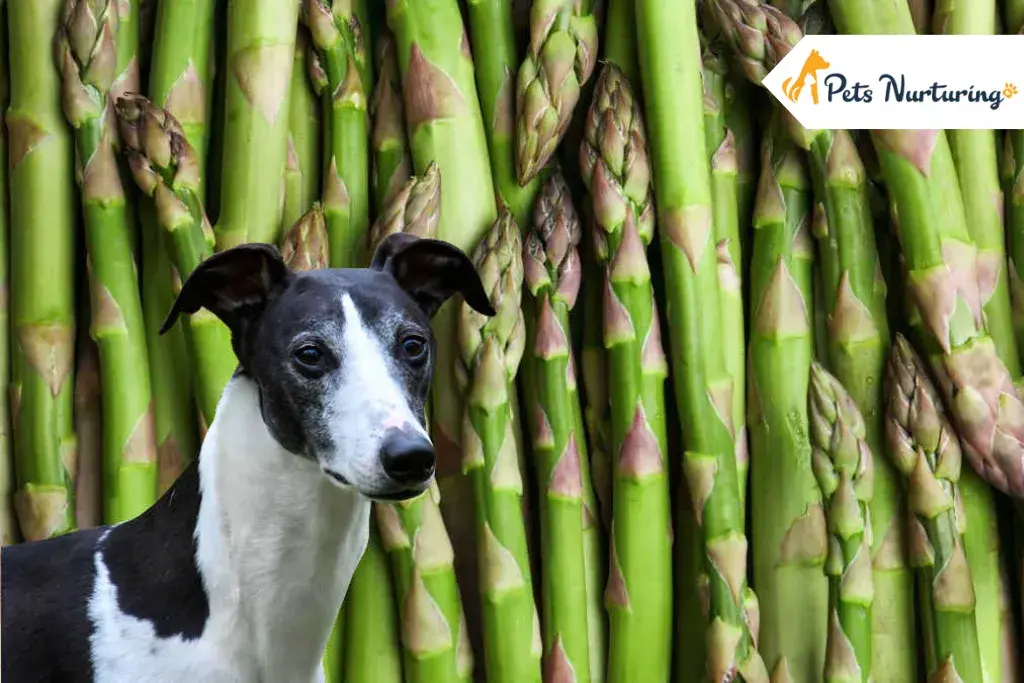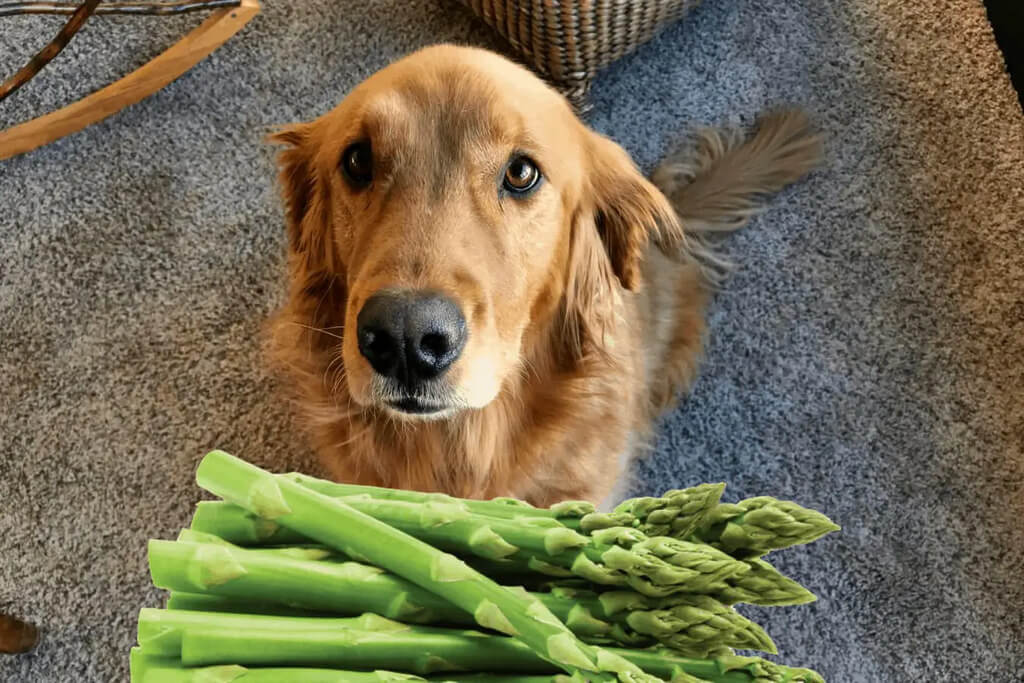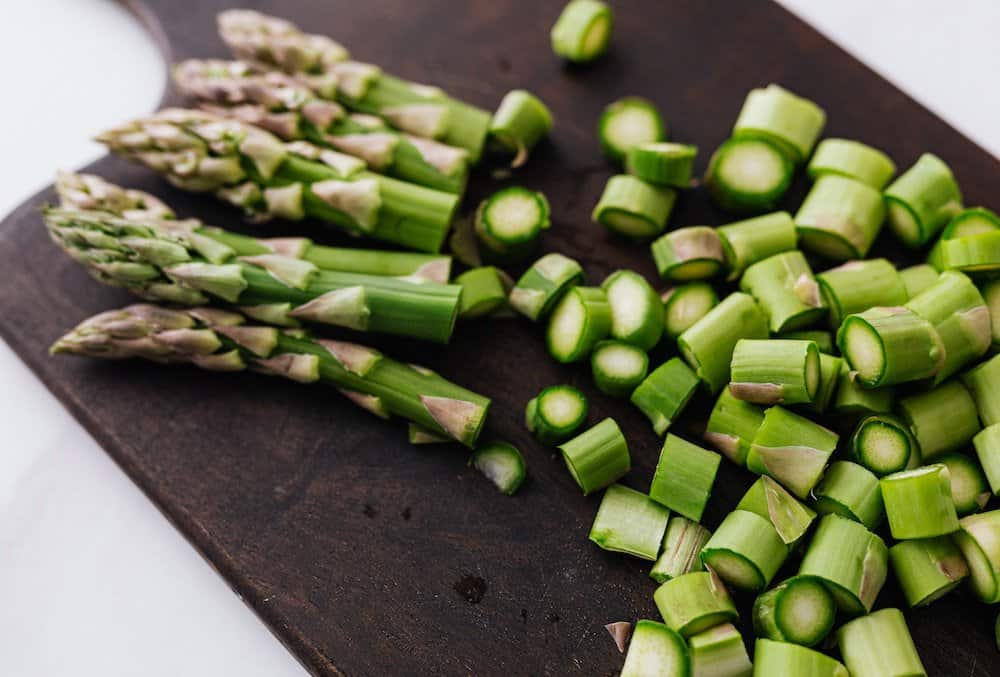
I love bonding with my dog by sharing foods I enjoy. With spring coming, it’s asparagus season—a special time. Asparagus is unique; we eat the young stalk before it gets leaves, fruits, or seeds. But when it comes to dogs, the safety of Asparagus as a treat is a bit of a mystery. So, getting back to the question, can dog eat Asparagus?
- Is Asparagus Good for Dogs? Can I Give It to My Dog Safely?
- Is Asparagus Healthy for My Dog?
- The Benefits of Asparagus for Dogs
- Can Dogs Eat Raw Asparagus?
- Can Dogs Eat Cooked Asparagus?
- The Risks of Asparagus for Dogs
- How to Feed Asparagus to Your Dog
- Can Dogs Have Asparagus: Asparagus Serving Ideas
- How Much Asparagus Can Your Dog Eat?
- Are Asparagus Bad For Dogs?
- Asparagus Recipes for Dogs
Is Asparagus Good for Dogs? Can I Give It to My Dog Safely?
Sure, dogs can have the part of Asparagus that we eat—the soft, cooked stalks and tips. But be cautious: raw Asparagus might be hard for dogs to digest, and whole stalks could cause choking.
If you get raw Asparagus, chop off the tough bottom part and cook it till it’s soft. After that, it’s safe to give some to your dog.
A heads up: If asparagus plants grow, they might develop little red “berries.” These pods are toxic to both dogs and humans, so it’s safest to stick to eating Asparagus when it’s still in the tender shoot stage. Let’s see can dogs eat asparagus?
Eating those berries can make you and your dog throw up, get a stomachache, or have diarrhea. This is mainly an issue if you’re growing Asparagus in your garden. To keep your dogs safe, a strong fence around the garden should do the trick.
Is Asparagus Healthy for My Dog?

Dogs, like us, are omnivores. They get the same perks from veggies and fruits as we do. These foods are low in fat and sugar but rich in vitamins and fiber.
Asparagus comes loaded with folic acid, fiber, potassium, thiamin, vitamin B6, and vitamin A, which are essential nutrients for canines. While dogs benefit from a bit of fiber, too much can lead to gas and diarrhea. Read this article to know can dogs eat asparagus?
The Benefits of Asparagus for Dogs

People love Asparagus not only for its taste but also for its incredible nutrition. And guess what? Many of those vitamins and minerals that are awesome for us are great for your furry buddy, too! Asparagus offers:
- Dietary fiber
- Folic acid
- Manganese
- Phosphorus
- Potassium
- Selenium
- Thiamin
- Vitamin A
- Vitamin B6
- Vitamin C
- Vitamin E
- Vitamin K
These nutrients do wonders! Asparagus’s antioxidants help clear toxins and free radicals from your dog’s blood. Plus, these essential vitamins and minerals help their immune system, maintain a shiny coat, sharp eyesight, strong teeth and bones, and a lot more.
Asparagus has health advantages for your dog, no doubt. But is it a good idea to add it to your dog’s diet, or is it too risky?
Can Dogs Eat Raw Asparagus?
Certainly! Dogs can have raw Asparagus, but it’s tough and hard to chew, making it tricky for them to digest. Raw Asparagus could cause choking or blockages in the tummy. It might also lead to gas, vomiting, or diarrhea for your dog.
Can Dogs Eat Cooked Asparagus?
Cooked Asparagus is safer for dogs when prepared properly, as it’s easier to swallow, chew, and digest.
When cooking Asparagus for your dog, make it plain. Avoid adding butter, onion, salt, garlic, or any other ingredients that might harm your dog.
The Risks of Asparagus for Dogs
While Asparagus is loaded with good stuff for your dog, it also brings several risks for your furry friend. So, before sharing the Asparagus from your dinner plate with your pup, it’s wise to reconsider.
1. Choking Hazard
Asparagus poses a big risk for dogs because it’s not soft and can lead to choking. Those stalks are tough and not easy to chew, whether for humans or dogs. Since many dogs gulp down their food without chewing, a hard asparagus stalk might get stuck in their throat.
It’s super easy for dogs to choke on longer asparagus pieces, especially ones longer than a few centimeters. If you’re sharing Asparagus with your dog, cut it into small bits.
Raw Asparagus is even tougher than cooked. Just like you wouldn’t eat raw Asparagus, avoid giving it to your dog. It’s hard on their tummy and a serious choking hazard.
2. Upset Stomach
Raw Asparagus is tough for your dog to digest. Cooking it helps a bit, but it might still cause issues like an upset tummy, gas, or even vomiting and diarrhea. It’s ironic, though, that Asparagus is good for digestion; too much fiber from it can lead to gas and other tummy problems.
Whenever you introduce a new food to your dog, it might upset their stomach, cause diarrhea, or make them throw up, especially if it’s in big amounts. So, if you’re thinking of giving Asparagus to your dog, start with a tiny bit.
Another hiccup with Asparagus is how we usually cook it with butter or oil. But these aren’t safe for dogs. Cooked Asparagus might also have salt, pepper, garlic, cheese, and other yummies, but these can make your dog sick.
Garlic and onions are big no-nos. They contain toxins that can poison dogs, including garlic and onion powder and any raw or cooked form of these veggies.
3. The Asparagus Fern
Asparagus plants give us those yummy stalks we enjoy cooking and eating. But the asparagus fern, even though related, isn’t edible. Plus, it’s not exactly a true fern.
The tricky part? This non-edible fern is a hazard for your dog. Eating it can bring on tummy troubles, vomiting, and diarrhea.
If you have asparagus ferns in your yard or garden, fence them off to keep your dog safe during their outdoor adventures.
How to Feed Asparagus to Your Dog

If you’re planning to give your dog asparagus, do it safely. Here are a few speedy tips to keep in mind:
- Ensure proper cooking. Avoid giving your dog raw Asparagus—it’s a choking hazard and tough to digest. Instead, steam or boil the asparagus spears; this prevents harmful ingredients and retains nutrients.
- Cut it into small bits. Always slice the Asparagus into smaller pieces for easier chewing and swallowing.
- Skip the extras. Don’t offer your dog Asparagus with added salt, pepper, oil, butter, cheese, garlic, or onions.
- Control the portion. Like any new food, too much Asparagus might upset your dog’s tummy. Stick to a small amount to avoid digestive issues.
Can Dogs Have Asparagus: Asparagus Serving Ideas

Make sure the Asparagus is soft and well-cooked for your dog. Cut it into small pieces to prevent choking.
Here are some ideas:
- Make a veggie soup with cooked Asparagus, carrots, and sweet potatoes in bone broth for your pup.
- Cook up some doggy risotto by adding chopped Asparagus to rice cooked in chicken broth for the last 10 minutes.
- Share a plain, cooked asparagus spear from your meal as a healthy snack for your dog.
- Remember, if you’re giving your dog asparagus, chop it into small, easy-to-chew bits after cooking to ensure it’s soft enough.
How Much Asparagus Can Your Dog Eat?
Offer treats and snacks in moderation, just 10% of your dog’s diet. The remaining 90% should come from a balanced dog food diet.
Too much Asparagus might upset your dog’s stomach, leading to vomiting, gas, or diarrhea. Stick to these suggested portions to keep your dog feeling good:
| Dog Size | Asparagus Portion | Examples |
| Extra-Small (2-20 lbs) | 1 teaspoon of asparagus | Yorkies, Pomeranians, Chihuahuas, Pugs |
| Small (21-30 lbs) | 2 teaspoons of asparagus | Basenjis, Miniature Australian Shepherds Beagles, |
| Medium (31-50 lbs) | 2-3 teaspoons of asparagus | Basset Hounds, Australian Cattle Dogs Border Collies, |
| Large (51-90 lbs) | 1-2 tablespoons of asparagus | Pit Bulls, Labrador Retrievers, German Shepherds, Australian Shepherds |
| Extra-Large (91+ lbs) | 2-3 tablespoons of asparagus | Newfoundlands, St. Bernards, Bernese Mountain Dogs, Great Pyrenees |
Are Asparagus Bad For Dogs?
Asparagus isn’t harmful to dogs, but it’s best to trim the tough ends and cook it till it’s soft before giving it to your dog.
However, there’s a different plant called the “asparagus fern” that’s toxic to dogs. Even though it’s related to the edible Asparagus we eat, this plant isn’t safe for humans or dogs to consume. When experts mention that asparagus leaves can be toxic to dogs, they’re usually referring to the asparagus fern and similar plants, not the kind we eat.
If you’re growing Asparagus, be cautious of the red seedpods that appear after the plant flowers. These pods are toxic and can lead to vomiting and diarrhea in dogs.
Asparagus Recipes for Dogs
If your dog likes and handles asparagus fine, feel free to add it to homemade dishes like sweet potato casserole or chicken pot pie bites.
For a crunchy and colorful treat, cook asparagus stalks, green beans, and sweet potatoes in a dehydrator.
Dehydrated Vegetable Dog Treats
You can dehydrate dog-friendly veggies you have, like pumpkin, carrots, squash, and zucchini strips. This guide focuses on dehydrating green beans, sweet potatoes, and bell peppers, but you can try it with any safe fruits or veggies. Enjoy experimenting and have fun!
Preparation Time: 8 hours
Total Time: 8 hours
Makes: 5 trays
Category: Healthy Snacks
Recipe by: Kiki Kane
Ingredients:
- 1/2 pound of green beans
- 2 large sweet potatoes
- 2 red bell peppers
- 1 pound of asparagus spears
Equipment:
- Oven or dehydrator
- Ice for an ice bath
- Cookie sheet and towels or paper towels for drying after blanching
- Stockpot for blanching
- Optional: Mandoline for slicing
Here’s how to do it:
- Fill a stockpot about three-quarters full of water and bring it to a boil. If it boils before you’re ready, just lower the heat a bit—it’ll perk back up fast.
- Rinse all your veggies thoroughly.
- Trim the ends off your green beans or Asparagus and keep them aside.
- Peel the sweet potatoes and slice them into 1/4″ pieces, rounds, or strips. If you’ve got a mandoline, it speeds things up.
- Drop the green beans, Asparagus, and sweet potatoes into the boiling water and blanch them for 4 minutes.
- Get a big bowl filled with ice and cold water ready to drain the blanched veggies when they’re done.
- For the bell peppers, remove the seeds and white pith, then slice them into 1/4″ strips.
- Use a strainer to scoop the beans and potatoes out of the boiling water and quickly transfer them into the ice bath.
- Once they’re out, add the bell pepper strips to the boiling water for 1 minute, then dunk them in the ice bath, too.
- After cooling, it’s time to dry them. Lay a clean, dry tea towel or two layers of paper towel on a large cookie sheet or pan.
- Put the cooled veggies on the towel, cover them with another towel, and layer more veggies on top until they’re all in. Gently pat or squeeze.
- Arrange the dried veggies on dehydrator trays, making sure nothing’s touching.
- Dehydrate at 110-140 degrees for at least 8 hours.
- If you prefer chewier sweet potatoes, take them out and keep drying the rest until they’re crisp.
- Once fully dehydrated, let the veggies cool to room temperature, then store them loosely in an airtight container or bag.
Notes
To make the veggies crisper, leave them in the dehydrator for a bit longer. If you’re using an oven instead, set it to the lowest temperature and start checking after 4 hours, then every 30 minutes until they’re dry enough.
The crispy ones will last longer than the chewier ones. Eat the chewy ones in a few days, or store them in the fridge. Crispy veggies, kept in an airtight container, should stay good for about two weeks.
FAQs
Most vets suggest the 10% rule: treats should only make up 10% of your dog’s daily calories. Asparagus is mostly water, with three grams of fiber and around 28 calories per cup.
White Asparagus is safe for dogs to eat since it’s not toxic for them.
Asparagus, being low in potassium, can be beneficial for their kidneys. Dogs with kidney disease sometimes develop ulcers, and high-fiber foods like Asparagus can assist in their treatment.
Conclusion
Are Asparagus good for dogs? Of course, dogs can have Asparagus, but it might not be the best choice. Raw Asparagus can be tough to chew and digest, so softer veggies might be easier for them. Also, if you grow Asparagus at home, watch out for your dog eating Asparagus fern. It’s not safe for them.
Explore Further











